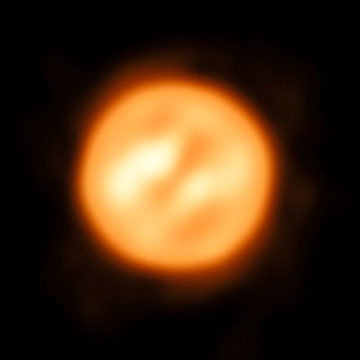Researchers have constructed a detailed view of the surface of red supergiant star Antares, revealing a chaotic atmosphere powered by mechanisms that are still poorly understood.

ESO / K. Ohnaka
An international group of astronomers has mapped the surface of red supergiant star Antares, one of the brightest stars in the sky.
The image shows the star’s surface with sufficient detail to reveal two large bright spots. Researchers also identified several clumps of gas moving up and down within the atmosphere at speeds of 20 kilometers per second (45,000 mph). The results appear in the August 16th Nature.
Antares is a massive star nearing the end of its life, with 15 times the mass and 10,000 times the visible luminosity of our Sun. It’s located 550 light-years from Earth, in the constellation Scorpio. With 883 times the girth of our host star, Antares is big enough to fill the solar system beyond the orbit of Mars.
Even though it’s not exactly close to Earth, Antares appears large and bright in the sky, making it an ideal candidate for direct imaging to resolve its surface features.
To achieve the unprecedented view, Keiichi Ohnaka (Universidad Católica del Norte, Chile) and colleagues observed Antares for five nights using the Very Large Telescope Interferometer at Paranal Observatory in Chile. The VLTI can combine the light gathered by its four 8.2-meter telescopes, or even its four 1.8-meter auxiliary telescopes, to achieve incredible spatial resolution. In this case, Keiichi’s team used three of the smaller auxiliary telescopes, achieving the sharpness equivalent to an 82-meter telescope. The researchers also used VLTI’s near-infrared instrument AMBER, which allowed them to make measurements over a small range of wavelengths.
These observations offer an unprecedented view of the surface of a star other than our Sun. Red supergiants like Antares are constantly expelling atmospheric material out into space, revealed in the powerful up-and-down motions of gas clumps.
“The star [Antares] is not expelling the material in an ordered, laminar, and spherical way, but in a turbulent, random way”, says Ohnaka. “Our velocity map shows that the gas motion is chaotic, turbulent, with many large gas clumps like turbulence air pockets you feel during an [airplane] flight.”
The mechanisms that govern the choppy stellar wind are poorly understood. The new observations could help link the forces that power the turbulent gas motions and ultimately expel material. These forces “may be related to magnetic fields, like in the Sun, or something else. But these ideas have yet to be tested observationally,” says Ohnaka.
In the future, Ohnaka’s team intends to create additional velocity maps at different depths in the star’s atmosphere in order to construct a three-dimensional view of the stormy atmosphere.
References:
Ohnaka et al. “Vigorous atmospheric motion in the red supergiant star Antares.” Nature. August 2017
 3
3









Comments
Anthony Barreiro
August 30, 2017 at 5:37 pm
Wow. I am just amazed to see a picture of Antares with such well resolved surface features. Bravi!
You must be logged in to post a comment.
relh
September 1, 2017 at 11:13 pm
Do the researchers know the axis of rotation? It would be interesting to know if the apparent banding can be correlated with rotation.
You must be logged in to post a comment.
September 2, 2017 at 1:42 pm
Our Moon or Sun is about one half degree angular wide or a thumb width at arm length . Nearby stars average about over 50-100,000 strung in a straight bead to equal Moon angular width . Betelguese is the widest angular star by far. The glow of the stars greatly exaggerate the physical breadth of the stellar spherical bodies due to its sheer brightness. The width of the glow will probably remain the same if you travel most of the way toward it except vastly increased brightness . when you are in the last light year away from it, who knows.. you will probably be dead!
Some stars are that hot even a light year away or two or even more!
Right? I can imagine so........
You must be logged in to post a comment.
You must be logged in to post a comment.